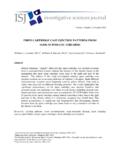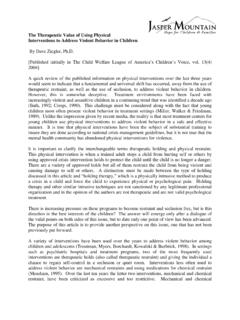Transcription of Journal of The Association for Crime Scene …
1 The Scene Journal of The Association for Crime Scene Reconstruction What s Inside From the Editor s Desk: Developing internship programs 4 2007 Conference Announcement 7 Article: An Examination of Police Officer Mental Chronometry 11 Crime & History: The Ruxton Case 26 Training Opportunities 27 Article: A Comparison of Luminol vs.
2 Bluestar in detecting blood at Crime scenes 28 Tricks of the Trade: 42 Forensic Workshop: 43 Web Site Information 45 Instructions for Authors 46 Trivia Question: What is meant by the term Burking ? (answer on page 6) AN EXAMINATION OF POLICE OFFICER MENTAL CHRONOMETRY: I DON T KNOW HOW I SHOT HIM IN THE BACK by Jeffrey B. Bumgarner, Texas Christian University William J. Lewinski, Minnesota State University William Hudson, Minnesota State University Sgt. Craig Sapp Tempe Police Department Abstract Every year, dozens of suspicious deadly force encounters involving police officers who have shot suspects pit the reputation of well-regarded and highly trained officers against physi-cal evidence which suggests the officers acted maliciously.
3 In particular, suspects are some-times found to have been shot in the side or back despite the protestations from the firing offi-cers that they had perceived frontal threats from the suspects. While officer malice is one possi-ble (and sometimes probable) explanation for such shooting incidents, other explanations may also exist. This article reports the findings of a 4-experiment study involving 102 police offi-cers in a major police department in the Southwestern United States. The results of the study demonstrate that many variables go into an officer s ability to react to stimuli in a timely man-ner and that even in laboratory conditions, there is ample time for the threat picture to change before an officer can either turn on, or turn off, a decision to react by firing a weapon.
4 Background There has been considerable attention in criminal justice and criminological scholarly and professional literature on the use of force , including deadly force , by police officers. Com-monly, the literature has focused on officer misconduct and outright unlawfulness. Indeed, many criminal justice studies exist which examine the reasons behind violence committed by police officers against citizens. In the landmark case of Graham v. Connor (1989), the Supreme Court declared that the use-of- force by police officers must be objectively reasonable under the 4th Amend-ment. For many contemporary observers and critics of the police who occupy seats in commu-nity organizations and academia, it is difficult for them to find examples of police use-of- force that meet the standard of objective reasonableness; for some, there is an apparent reflex to find the police at fault in almost any circumstance.
5 They apply a standard of what is objectively rea-sonable to them (the critics) with the benefits of hindsight, unlimited contemplation, and com-plete information. They do so in spite of the Supreme Court s admonition in Graham v. Con-nor to determine the objective reasonableness of use-of- force encounters by looking through the eyes of a reasonable police officer in the same circumstances and timeframe as existed when the use-of- force took place. Instead, the standard often applied to law enforcement use-of- force action is to presume improperness and excessiveness unless the evidence clearly demonstrates otherwise. Conse-quently, when the physical evidence at first glance appears to contradict the account given by the offending police officer, there is almost never an extension of benefit of the doubt to such officers.
6 Nor is there an assumption that a rational explanation which supports the officer s ac-count might exist and is awaiting discovery. The Sources of Police Violence The various academic studies on police violence seem almost universally unaware of alternative explanations for violent acts committed by police officers. The studies tend to ap-proach the broad issue of police violence as always a matter of misconduct and usually a matter of criminality. Some suggest that the para-military structure and culture of modern police agen-cies contribute to violence perpetrated by police against elements of the citizenry (1-3). They would argue that police agencies must be flexible and adaptive to the changing conditions in the communities they serve and to changing societal norms (4).
7 A related claim is that police violence can be curtailed through organizational pro-activity via human resource management and policy enforcement (5-7). Smith (8) on the other hand found that personnel and policy variables were poor predictors of police killings. Instead, levels of community violence and community racial composition were positively related to deadly force encounters (8, 9). Other researchers have claimed that tendencies to use violence to bring about order are inherent in many individuals drawn to police work (10-12). Still another explanation relates generally to the training of police officers. James Fyfe (13) noted that police officers who are properly trained to diffuse potentially volatile situations exert considerably less force than offi-cers without such training.
8 Many criminal justice scholars are sufficiently concerned about the phenomenon of po-lice violence that they have called for added layers of review. Alpert and Smith (14) suggested that all force encounters between police and citizens should be routinely subject to supervisor review. The supervisor would be obligated to consider the input of not only the officer(s), but also the suspect(s) and any other witnesses. Further, they recommend that panels of experts also be regularly convened to determine the appropriateness of any police encounters involving force . Indeed, scholarly criminal justice literature is saturated with many plausible explana-tions for police violence, along with many useful (and some not so useful) recommendations to curb it.
9 These explanations and recommendations come from many directions, but virtually all rely on the basic premise that law enforcement needs to fix itself. In other words, the tone and tenor of the explanations and recommendations from academe is that police violence is an avoidable tragedy that can be significantly reduced if police organizations and individual offi-cers would get their acts together. Although it is true that sociological and organiza-tional variables, including the background and personalities of the of the officers, the biases of the officers, structural impediments to change, the presence or lacking of viable use-of- force policies, and many other factors may play a role in incidents of police violence, an alternative explanation for some questionable deadly force encounters does exist.
10 The explanation is sim-ply this: many incidents involving the apparent misuse of force by police officers can be ex-plained by the realities of human psychological and physiological limitations. The nature of any inherent human limitation manifested in the real world is that it must be understood and accounted for because it cannot easily be overcome. The Science of Human Reaction The scientific study of how quickly the human mind and body can and do react to stim-uli (known as mental chronometry) goes back at least to the middle part of the 19th Century. For example, in 1865 Donders conducted experiments involving a mild electric shock to the right or left foot of his subjects. The subjects would then press a telegraph key with their right or left hands to indicate which foot had received the shock.









